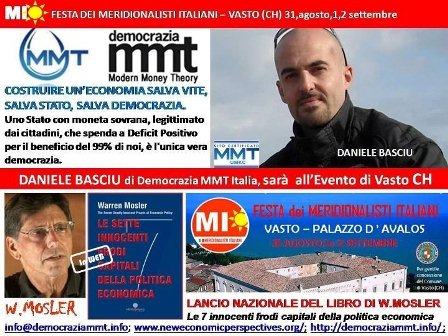>
> (email exchange)
>
> On Fri, Aug 24, 2012 at 5:28 AM, Dave wrote:
>
> When you get a chance could you send a quick note out on problems with this type of
> thinking?
>
The reasons nations have gone off the gold standard isn’t because it was working so well and their economies were doing well. The reason they go off, like the US did in 1934, was because it was a disaster.
Historically nations suspend their gold standards in times of war, when they need their economies to function to the max. If a gold standard was so good for an economy, why suspend it when you need max economic performance? Obviously because it is not conducive of maximum real output.
The ideological issue is whether the primary function of the currency is to be an investment/savings vehicle, or a tool for provisioning government and optimizing real economic performance. In a market economy you can’t fix the price of two things without a relative value shift causing you to be buying one of them and running out of the other. Likewise, you can’t sustain full employment and a stable gold price if there is a shift in relative value between the two.
A gold standard is a fixed exchange rate policy, where the govt continuously offers to buy or sell gold at a fixed price.
This means the holder of a dollar, for example, has the option of ‘cashing it in’ for a fixed amount of gold from the govt, and a holder of gold has the option of selling it at a fixed price to the govt.
Therefore a new gold discovery which causes gold to be sold to the govt is inflationary and tends to increase output and employment, and a gold ship sinking in transit or a sudden desire to hoard gold is deflationary and tends to decrease output and employment. And there’s nothing that can be done about these relative value shifts, except to ride them out. The only public purpose served (by definition) is the stable nominal price of gold set by Congress.
With a gold standard, like any fixed fx regime, interest rates are necessarily set by market forces. With the govt’s spending being convertible currency, it is limited to spending only to the extent it has sufficient gold reserves backing the currency it spends. With gold reserves generally pretty much constant and not expandable in the short run, this means govt spending is limited to what it can tax and/or borrow. So when the govt wants to deficit spend, doing so by ‘printing’ new convertible dollars risks those dollars being ‘cashed in’ for gold. Govt borrowing, therefore, functions to remove that risk by delaying conversion privileges until the borrowings mature. This means the govt is competing with the right to convert when the govt borrows. In other words, the holder of the gold certificates has the option of either converting to gold or buying the treasury securities. The interest rate the treasury must pay therefore represents the indifference rate of holders of the convertible currency between cashing in the currency for gold now or earning the interest rate and not being able to convert until maturity. Note that it’s in fixed exchange rate environments that govt borrowing costs have soared to triple digits as govts have competed with their conversion features, and that govts generally lose those fights as the curve goes vertical expressing the fact that at that point there is no interest rate that can keep holders of the currency from wanting to convert.
Note that this also means the nations gold reserves are the net financial equity that supports the entire dollar credit structure, a source of continuous financial fragility and instability.
It’s all here in a paper I did in the late 1990’s.
Hope this helps!
A few more thoughts:
Being on the gold standard doesn’t prevent a financial crisis, but it makes the consequences far more severe.
We were on a gold standard when the roaring 20’s private sector debt boom lead to the crash of 1929 and the depression that followed. 4,000 banks closed before we went off gold in 1934, and it was only getting worse which is why we went off of it.
Gold would not have prevented the pre 2008 sub-prime boom, but it would have made the consequences far more severe. Including no Fed liquidity provision to offset a system wide shortage due to hoarding and banks bidding ever higher for funds that didn’t exist, most all firms losing inventory financing and being forced to liquidate inventories as rates spiked competing for funds that didn’t exist, and no deficit spending for unemployment comp as federal revenues fell from the collapse. In other words, the automatic fiscal stabilizers we rely on can’t be there. Instead it’s a deflationary disaster that only ends when prices fall sufficiently to reflect changes in relative value between gold and everything else.
Note that the recent decade of gold going from under $600 to over $1,600 is viewed as a sign ‘inflationary’ and a 250% ‘dollar devaluation’ as it takes 2.5x as many dollars to buy the same amount of gold. But if we were on a gold standard, and all else equal, and gold had been fixed at $600 back then, the same relative value shift would be manifested as the general price level falling that much in an unthinkable deflationary nightmare.

